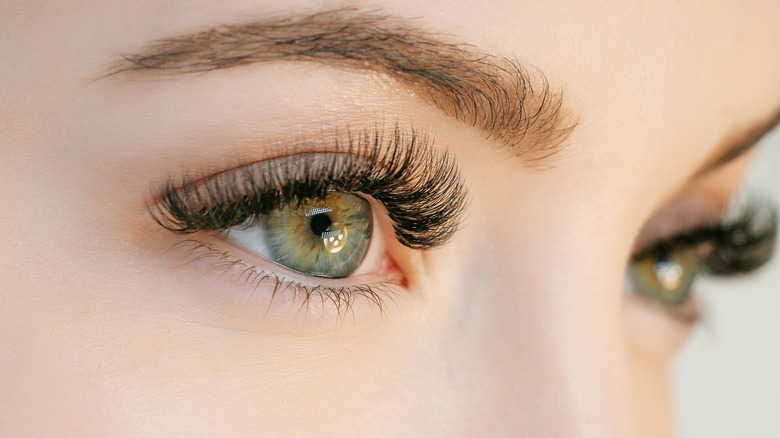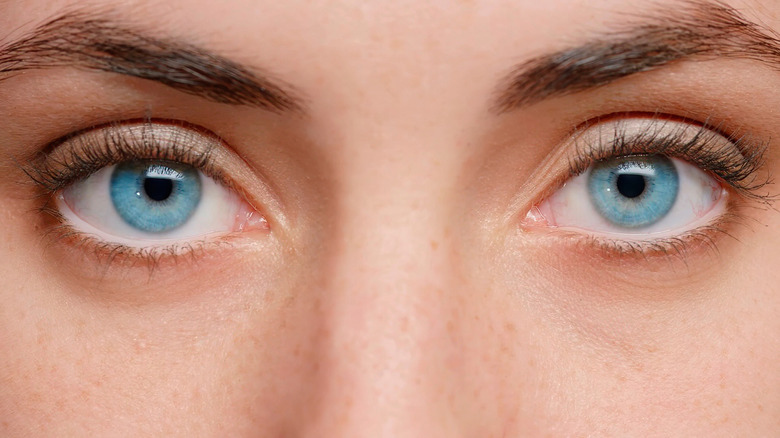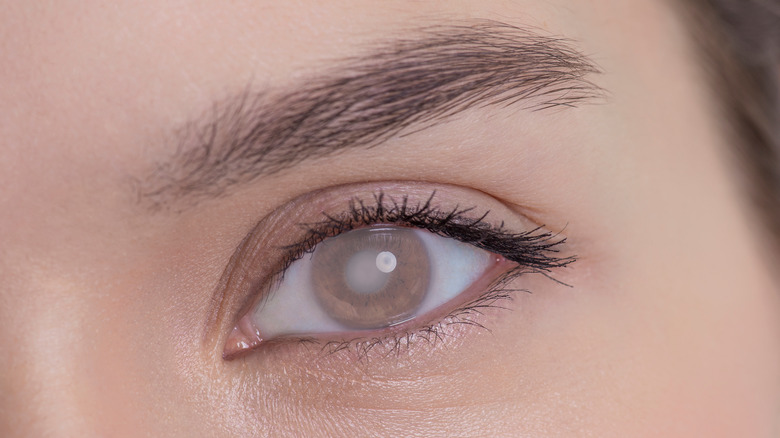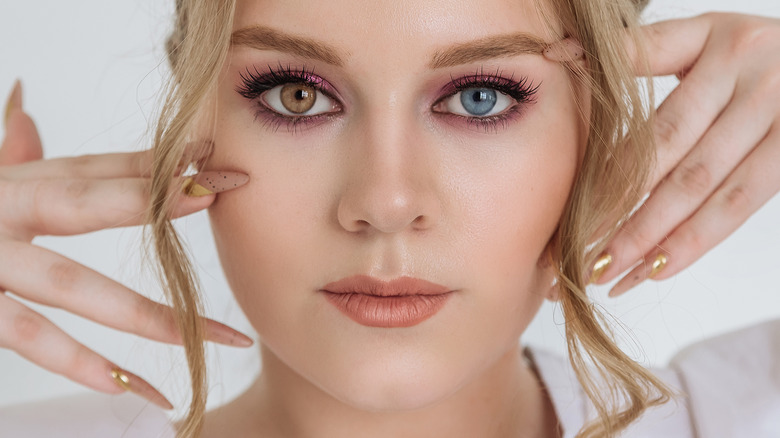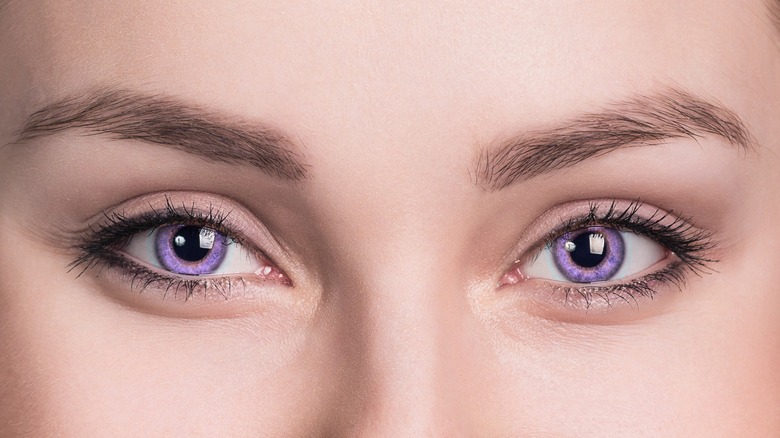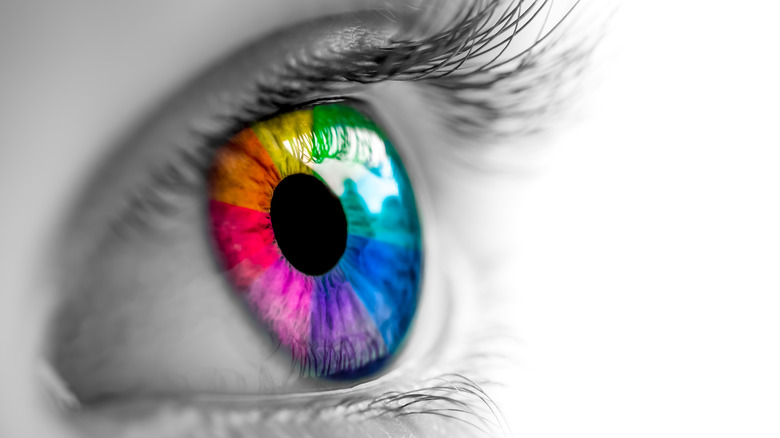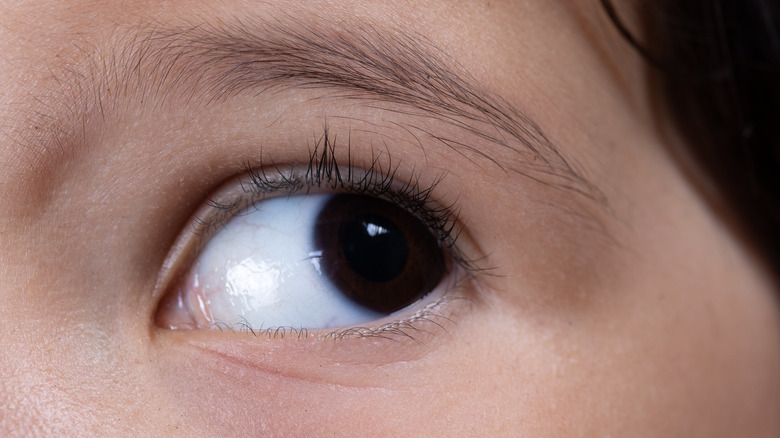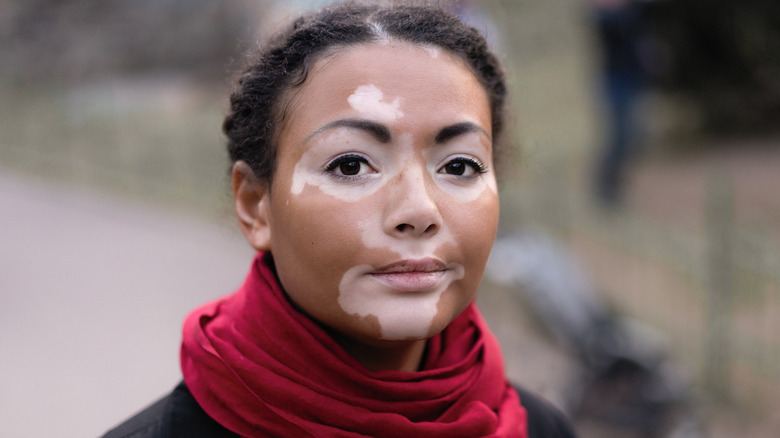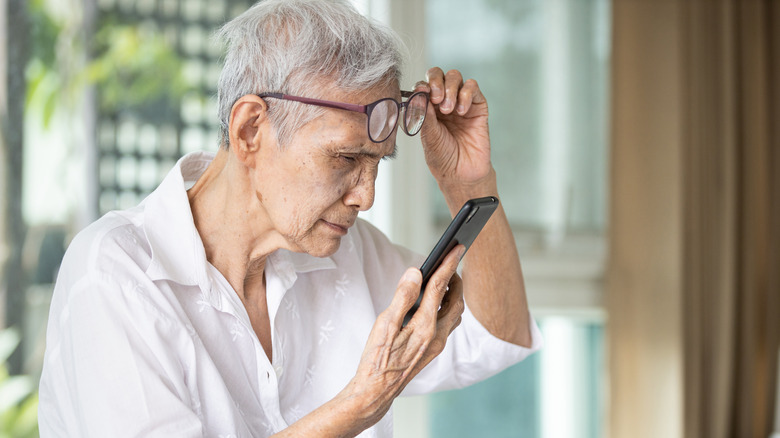Surprising Things Your Eye Color Can Tell You About Your Health
If you want the truth from someone, you might insist that they look you in the eye. But did you know that you can learn a number of truths from simply looking at your own eyes? And no, not a discoloration like a pink or yellow sclera (aka the white part of the eye). Yes, there is solid evidence that your baby blues, bewitching greens, or big brown eyes are all more than just mirrors to your soul.
As Medical News Today explains, there are a number of genes involved when it comes to the colors of eyes, but the most essential component is a brown pigment called melanin. But wait, shouldn't there be other pigments for other eye colors? Actually, no, eyes that aren't brown simply have lower amounts of melanin, which means they absorb less light and so reflect other colors.
Granted brown is the most common eye color in the world, but some shades we often think of when it comes to our peepers are blue, hazel, and green. Fun fact: Only about 2% of the world's population have green eyes (via Medical News Today). Even eye hues that are thought of as more unusual, like amber and gray, are technically more common than green eyes. But no matter which shade you have, your eyes can reveal important advantages and even potential health issues.
Green eyes and photophobia are connected
The term "phobia" automatically conjures up the idea of fears. After all the film "Arachnophobia" was all about fearing spiders (or, specifically, one very dangerous killer spider). But in this case, photophobia actually refers to being sensitive to –not scared of — light (via WebMD).
Now, of course, everyone squints and feels momentarily uncomfortable when they go from a dark room into a brightly lit one. But if you have photophobia, light — like the blue light from your smartphone or laptop — can cause you pain. And as Dr. Anupama Horne, an ophthalmologist at Duke University, confirmed, green eyes, as well as blue and gray ones, can be especially sensitive to light. Why? Because all eyes have varying amounts of brown pigment, which acts almost like built-in sunglasses. The lighter your eyes, the less pigment they contain, and so, the less natural shielding they have against various light sources.
If you think you may have photophobia, WebMD notes a possible solution: wearing rose-colored glasses (and, no, that's not meant metaphorically). That said, tinted lenses can exacerbate symptoms of light sensitivity in some people, so it's important to speak with your eye doctor. And if you're concerned someone you know may be photophobic, look for signs like if they constantly rub their eyes or are often squinting.
The lighter your eye color, the higher your risk of cancer
Now, don't panic. The shade of your eyes isn't a guarantee that you'll develop cancer. But just as it's good to be aware of things like family history when it comes to your health, you should know about possible risks and what you can do to minimize them.
As Everyday Health explains, lighter eyes have less pigment than darker eyes, which means they have less protection from the sun's UV (ultraviolet) rays. Unfortunately, this means they're at greater risk for a rare but still dangerous form of melanoma — specifically the version of this cancer that can develop in your uvea (the middle layer of your eyes). In fact, research has supported that blue-eyed and green-eyed individuals are the most likely to develop melanoma in their eyes (via Reader's Digest). And there's more bad news.
According to a study published in Cancer Epidemiology, Biomarkers & Prevention, children with blue eyes are more likely to develop moles, which can mean they're more likely to develop melanoma (via Reader's Digest). On the flip side, individuals with darker-color eyes are less likely to experience skin cancer. However, don't despair. Being diligent about sun protection, including wearing sunglasses that block UV rays, is a simple solution. In fact, regardless of your eye color, this is a good practice for your general health.
Your eye color can make you more likely to develop cataracts
Unfortunately, the darker your eye color, the more likely you are to develop cataracts. In fact, one study found dark eye colors like brown "had a 1.5 to 2.5 times greater risk" of this medical condition where your vision becomes clouded, Prevention detailed.
But don't start to relax if you're eyes are a lighter shade. A study by Johns Hopkins found evidence that people with a combination of blue eyes and a fair skin tone are also more likely to develop cataracts. So, what do these eye colors have in common that makes them both so susceptible to this eyesight issue? Well, according to both Johns Hopkins and Prevention, a major factor is how the ultraviolet rays from the sun impact our eyes.
No matter your eye color, Prevention recommends everyone protect their eyes by wearing sunglasses. Johns Hopkins Medicine pointed out that you need to choose protective eye gear that not only will shield your eyes from both UV-A and UV-B rays, but also will wrap around the sides of your face. After all, it's easy to forget about the sunlight that isn't directly in your line of sight, but as much as 20% of UV rays can still reach your eyes from the sides of your head.
If you're eyes are two different colors, you might have Waardenburg syndrome
We've all seen cats that have two different colored eyes, but this somewhat unusual feature can happen with humans as well. More formally called heterochromia iridis, this is not something that should necessarily be ignored since it can be a sign of a hereditary condition called Waardenburg syndrome (via Healthline).
As Healthline explains, there are four types of Waardenburg Syndrome. Having different colored eyes or even pale blue eyes can be a symptom of three of the four versions of this syndrome. Other signs (depending on the type) may include eyes that are set wide apart, deafness, patches of white skin and hair, and often being constipated. But keep in mind that a person can have pale blue eyes or heterochromia and not have Waardenburg Syndrome, and while type 1 and type 2 of this condition are considered common, type 4 is a rarer form known as Waardenburg-Shah syndrome.
While there is no cure for any form of Waardenburg Syndrome, there are ways to better manage some of its symptoms (via Healthline). Constipation that sometimes accompanies Waardenburg-Shah syndrome, for example, is due to issues with the nerves in the bowel and can be treated with surgery. And hearing aids or cochlear implants can also be used if deafness occurs.
Alcohol, alcoholism, and eye color
Get ready because this one is a little tricky. On the one hand, there's evidence that people who have darker-colored eyes are more sensitive to alcohol (via Psychology Today). In other words, if you have brown eyes and your friend has blue eyes, you're more likely to feel tipsy after just one glass of beer while your friend might be able to drink two or three glasses.
So, does that mean dark-eyed individuals are the most likely to become alcoholics? Actually, it's the opposite. In fact, that sensitivity means people with darker eyes are more likely to drink less, and so avoid becoming physically dependent on alcohol. In contrast, evidence has shown that people with eye colors like gray, green, and blue are all more likely to consume higher amounts of alcohol, which can lead to alcoholism (via ScienceDaily).
If you, or anyone you know, is struggling with addiction, help is available. Visit the Substance Abuse and Mental Health Services Administration (SAMHSA) website or contact SAMHSA's National Helpline at 1-800-662-HELP (4357).
Are your irises violet? You may have ocular albinism
Before we really dive into this, there is a big difference between ocular albinism and albinism. Albinism is when a person is born with lower levels of pigment specifically in their skin and hair. This can give them a very fair skin tone and very light-colored hair. Ocular albinism, however, doesn't affect a person's skin or hair. Instead, their irises can appear to be red or pink, according to WebMD, or even violet (via Medical News Today).
However, it is more typical for a person with ocular albinism to have blue eyes (via WebMD). The reason they can look red, pink, or violet comes down to the levels of pigment in their irises; they're so low that the blood vessels are showing when they would normally be obscured. But beyond the unique eye color, those with this form of albinism can have other health issues, including blurry vision, difficulty with depth perception, uncontrollable eye movements, crossed eyes, photophobia, and lazy eyes.
But there is some good news. While some of the symptoms of ocular albinism can be troubling, WebMD notes that they sometimes do improve with age. Plus, it is unlikely that a person will lose their vision entirely as a result of this rare genetic condition. However, if you or someone you know has ocular albinism, tinted glasses or contact lenses can help with sensitivity to light.
What if your eye color changes?
Thanks to colored contact lenses, people have the option to see what they'd look like with a different eye color. But what happens when your eye color starts to change on its own?
According to the American Academic of Ophthalmology (AAO), one possible reason the hue of your eyes might look like a different color is a condition called pigment dispersion syndrome. Think of your iris like a window on your house that you've painted from the inside, so that it looks like a piece of solid-colored glass. Now imagine that, over time, the paint begins to break off and fall away in small bits from the window. Eventually, the window would look like it had lightened in color. The same thing happens to your eyes during pigment dispersion syndrome only when pigment breaks away from your iris, it can clog the fluid in your eye and cause changes in your eye's pressure (via AAO). And if left untreated, it can lead to a form of glaucoma.
While pigment dispersion syndrome can cause serious vision problems, there is also a harmless reason a person's eye color may appear to change. According to PrepScholar, the distribution of the pigment in hazel eyes can make them look like a different color depending on lighting conditions and the color of your clothes. In fact, it's not uncommon for someone with hazel eyes to appear to have blue-, green-, or amber-colored irises on any given day.
People with blue eyes may be more likely to develop type 1 diabetes
Sorry to anyone with blue eyes reading this, but unfortunately, research has shown you could be at a higher risk for type 1 diabetes. One study found that people in this group living in Lazio, a region in central Italy, and Sardinia, an island south of Corsica, were in some cases twice as likely to develop this condition.
It initially seemed that fair skin and blue eyes both increased this risk. However, ater some statistical analysis, the researchers determined that "only blue eyes are independent and significant predictors of T1D [type 1 diabetes]." There are a couple of things to keep in mind, though. This study references research focused on Caucasians living specifically in areas of Europe and the Mediterranean. And as Healthline notes, it is still not clear what causes type 1 diabetes. Yes, it seems genetics and a person's environment play a role, but a great deal about this disease remains unknown.
With that said, if you have any reason to be concerned about developing diabetes (whether it's the color of your eyes or your family's history), you should speak with your health care professional.
Very dark eyes or absent iris?
For cartoon characters like Mickey Mouse, not having irises is just part of their simple, charming designs. For all of us non-animated folks, however, having little to no iris can be a sign of a rare genetic disorder or a complication caused by eye surgery or trauma (via Verywell Health).
As Verywell Health explains, this condition goes by several names, including aniridia, congenital aniridia, irideremia, and (arguably the most straightforward one) absent iris. The severity of this eye issue can be minor, meaning so little of the iris is missing that it's almost unnoticeable. However, in more severe cases, it can come with a host of problems, ranging from sensitivity to light and involuntary eye movements to glaucoma, cataracts, scarring on the cornea, and even a rare type of kidney cancer called Wilms tumor.
It's important to note that even if it appears someone doesn't have an iris, an eye exam may reveal traces of one (via Verywell Health). While it is possible to surgically replace parts of the iris, surgeons often advise against doing so because it can cause the patient additional health problems. However, other surgeries like corneal transplants may be necessary if you have aniridia. In addition, you may need laser treatments and medications if you develop glaucoma as a result of this condition.
The darker your eye color, the more likely you'll develop vitiligo
Everyone naturally has pigment in their skin, but if a person has the skin condition known as vitiligo, their immune system mistakes their body's pigment for something dangerous, like a virus (via WebMD). As a result, their body's natural defenses begin attacking their pigment cells, which can cause white patches of hair and skin. And that's only the beginning of this autoimmune disease's possible impact. Beyond the patches, a person with vitiligo is at a greater risk of developing type 1 diabetes, lupus, rheumatoid arthritis, or autoimmune thyroid disease (via WebMD).
While individuals with dark-colored eyes are less likely to develop melanoma, they're more likely to develop vitiligo. "Genetically, in some ways vitiligo and melanoma are polar opposites," Dr. Richard Spritz, the director of the Human Medical Genetics and Genomics Program at the University of Colorado School of Medicine, explained to WebMD. "Some of the same genetic variations that make one more likely to have vitiligo make one less likely to have melanoma, and vice versa."
And if that's not enough to convince you, one study that researched a group of 450 people with vitiligo found that 43% of the group had either tan or brown eyes (via WebMD). And how did other eye colors fare? Thirty percent of the group had either green or hazel eyes while only 27% of the group had blue or gray eyes.
Endometriosis is more likely in women with blue eyes
Ladies, if you have blue eyes, this slide is crucial for you. According to WebMD, women with blue irises are more likely to develop a condition known as deep infiltrating endometriosis or DIE. And if that acronym isn't enough to get your attention, then the possible health complications will.
When a woman has this form of endometriosis, she in some ways has an inside-out uterus. Okay, that's an exaggeration, but tissue that should normally only grow on the inside of her uterus starts growing on the outside and can invade nearby organs (via WebMD). As a result, she may experience issues like constipation, bloating, blood in her urine and stool, pain in her lower back and pelvis, pain when moving her bowels, and pain while having sex (via Brigham and Women's Hospital). And in certain cases, if the condition is left untreated, one or more of her kidneys could shut down.
Since not all women with deep infiltrating endometriosis will show symptoms, it's important to keep up with your regular checkups and speak with your health care professional about possible risks, according to Brigham and Women's Hospital. If you do develop DIE, keep in mind that while there are non-surgical medical treatments available, often surgery is the only way to deal with possible complications from this disease.
The complicated relationship between seeing at night and eye colors
Unlike cats, we humans aren't known for our night vision. And when you start trying to factor in how eye color impacts your ability to see in the dark, things get a bit tricky. But let's take this one step at a time.
According to the American Academic of Ophthalmology, night vision is defined as "the ability to see in low light conditions." Remember, the more pigment you have in your irises, the darker the color, and this pigment can act like built-in sunglasses for your eyes (via Duke Health). Now, imagine you have two people in a dark room. One is wearing sunglasses and the other is not. The person wearing the sunglasses would have more difficulty seeing than their companion. The same concept applies to eye color. The darker your iris, the more difficulty you're going to have seeing when there's little light (via Brass Eye Center).
But wait, like an M. Night Shyamalan movie, there's a twist. While people with lighter eye colors tend to see better in the dark, night driving is another matter. Those same pigments that put dark-eyed individuals at a disadvantage give them an edge when dealing with cars' headlights and other reflective surfaces (via Rx Optical). So, while your blue- or green-eyed friend may be perfect for finding your lost car keys in the dark, you may want to hand those keys over to your friend with the brown eyes.
How well you tolerate pain may be connected to the color of your eyes
Whether it's emotional or physical, you can usually tell when someone is in pain just by looking in their eyes. But research is finding that if you have hazel or brown eyes, you might not tolerate pain as well as someone with green or blue eyes (via Medical Daily).
A study done by the University of Pittsburgh found that women with lighter eye colors tended to not only deal better with the pain of giving birth but also were less likely to experience postpartum depression (via Medical Daily). Dr. Inna Belfer, a geneticist involved in the study, explained at an annual meeting of the American Pain Society that "darker eye color has been reportedly found to correlate with increased physiologic reactivity," meaning how strongly someone reacts physically to stressors.
But why would the color of your eyes make such a big difference when it comes to pain tolerance? One possible explanation is the genes that help determine your eye color may also affect how you experience pain (via Medical Daily). Why? Because the same pigment found in your irises is also in your brain. Remember, the only pigment color in everyone's eyes is brown (via Medical News Today). It's the amount of this pigment that makes your eyes appear lighter or darker. So, higher levels of this pigment might mean both darker-colored irises and lower pain endurance.
The link between age-related macular degeneration and blue eyes
Okay, time for biology 101. The back parts of your eyes are lined with nerve tissues called your retina, and the central part of your retina is called your macula (via Retina-Vitreous Surgeons of Central NY, PC). Now, imagine your pupil and iris are like a movie projector at a theater and your retina and macula are the movie screen. If the screen is damaged (and especially if it's damaged in the center), the movie will appear distorted. The same basic concept happens when your macula is damaged only in this case, it's your vision that becomes distorted.
Unfortunately, as we age, the macula can deteriorate, a condition called age-related macular degeneration or AMD. And women as well as anyone with blue eyes, blonde hair, and a light skin tone are more likely to develop AMD. Plus, their chances go up more if they have other health issues like high cholesterol and high blood pressure.
If you are concerned you may have AMD, keep in mind that there are two versions of this eye issue. If you have Dry AMD, then cellular debris called drusen have gotten stuck and built up under your retina. Eventually, Dry AMD can progress where easily breakable blood vessels start growing into your retina. If this happens, you've now developed Wet AMD, which can cause blood in your retina and vision loss (via RVS).

